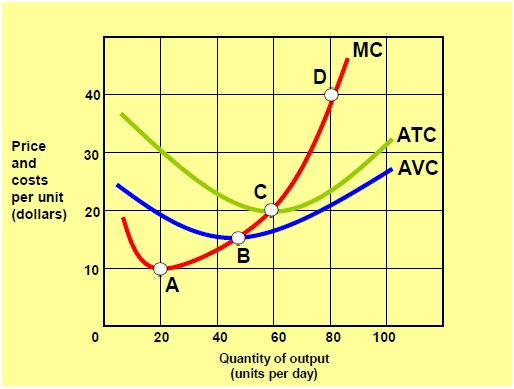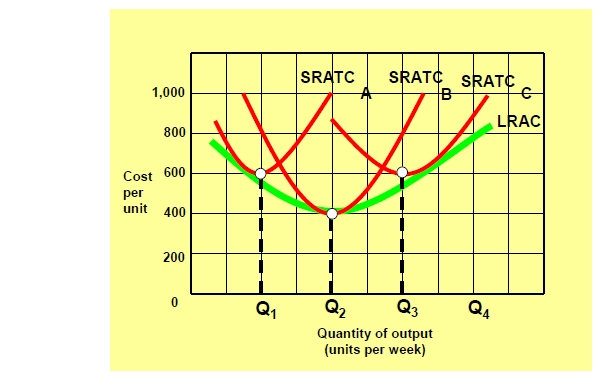Its total cost and its total variable cost
Chapter 6
1. If a firm pays the same amount of rent for the warehouse, irrespective of the quantity of its output, the rent is a(n) _____ for the firm.
equal to average variable cost.
4. The law of diminishing returns refers to a situation where:
the marginal product of labor is greater than zero but declining as more units of a variable input are hired.7. A firm will face a(n) ______ if it experiences diseconomies of scale. upward-sloping long-run average cost curve
8. Neha owns a boutique and earns a revenue of $100,000 per year. She made use of her spare apartment for her outlet that she could have rented out and earned $50,000 annually as rent. She incurs costs of $85,000 to run the boutique. In light of the above information, calculate Neha's accounting profit.
11. The _____ of a firm is represented by a downward-sloping curve. average fixed cost
12. Suppose a firm incurs a total cost of $50,000 and produces 5,000 units of output. The average total cost of by the firm is:
$10.The firm is operating in the long run.
15. An economist left his $100,000-a-year teaching position to work full time in his own consulting business. In the first year, he had a total revenue of $200,000 and business expenses of $150,000. He made a(an):
economic loss.
| $208. |
|---|
19. Economies of scale causes:
the long-run average cost curve to slope downward.
22. Suppose an entrepreneur rents a plot of land to set up a plant. The expenditure on the rent for the plot will be accounted for as the _____ for the firm.
explicit cost
25. Calculate the total fixed cost for a firm if its total variable cost equals $500 and the total cost equals $3,750.
$3,250
29. Implicit cost of a firm refers to:
the opportunity costs of using resources owned by a firm.30. A situation in which the long-run average cost curve of a firm declines as the firm increases output is known as:
economies of scale.34. A firm, in the short run, can alter all of the following inputs except the: size of the firm's plant.
35. Which of the following is true of the law of diminishing returns?
38. Which of the following conditions is mandatory for the law of diminishing returns to set in?
The firms should use at least one fixed factor of production.
42. If the units of variable input in a production process are 1, 2, 3, 4, and 5, and the corresponding total outputs are 30, 34, 37, 39, and 40. The marginal product of the fourth unit of the variable input is:
2.43. Suppose firm A acquires firm B, a rival firm, in order to expand its business operations. However, after a few months firm A realizes that its production cost has increased substantially after it took over firm B. This increase in the production cost can be attributed to:
diseconomies of scale.46. Which of the following statements is true?
Accounting profit equals total revenue minus opportunity cost.
49. The lowest point on the average total cost curve is: where it intersects the marginal cost curve.
3. A firm produces 30 units of output by employing 5 workers and earns a revenue of $50. When it hires an additional worker, the output increases to 38 units and the firm earns a revenue of $60. Therefore, the marginal revenue earned by this firm is:
$1.25.4. The long-run supply curve in a perfectly competitive constant-cost industry is: perfectly elastic.
7. In a perfectly competitive industry, assume there is a permanent increase in demand for the products. The process of transition to a new long-run equilibrium will be
characterized by:
entry of new firms into the industry.8. Suppose firm A operates in an industry where the products offered by each firm are perfect substitutes of each other. Firm A operates in a:
perfectly competitive market.13. Under which of the following conditions will a firm in a competitive industry continue to operate?
When MC = MR = ATC This is the correct answer When MC = AVC > MR
When MC > MR < AVC
When MC = MR < AVC16. Which of the following is not true of a perfectly competitive market? Each firm in a perfectly competitive market is a price maker.
17. Consider the following information about a perfectly competitive firm: AVC = $75, ATC = $90, and MR = $60. Which of the following should the firm do to maximize profits or minimize losses?
20. Which of the following is true of a perfectly competitive market?
23. A firm produces 130 units of output by employing 10 workers and earns a revenue of $500. If it hires an additional worker, the output increases to 150 units and the firm earns a revenue of $560. Therefore, the marginal revenue of the firm is:
$3.24. Which of the following best describes marginal revenue? Change in total revenue / 1 unit change in output
 |
|---|
28. As shown in the exhibit given below, the firm will produce in the short run if the price is
32. In the short run if a competitive firm is incurring economic losses, then it should: shut down if operating losses are greater than total fixed cost.
33. As shown in the exhibit given below, the price at which the firm earns zero economic
36. Perfectly competitive markets are characterized by: firms selling a homogeneous product.
37. In long-run equilibrium, a typical perfectly competitive firm: earns zero economic profit.
the minimum average total cost
41. Which of the following is true of the short-run supply curve of a perfectly competitive firm?
44. The demand curve faced by a perfectly competitive firm is _____. perfectly elastic
45. What is the shape of the demand curve faced by a firm under perfect competition? A horizontal line
3. A group of people with a perfectly inelastic demand is likely to be charged: the highest price by a price-discriminating monopolist.
4. Firm A is a monopoly and firm B is a perfectly competitive firm. The demand curve faced by firm A is _____.
8. Which of the following is a reason for the underallocation of resources by a monopolist? A monopolist charges a price higher than the marginal cost of production.
9. Suppose Edward's Pizzeria is the only pizzeria in the small town of Fordica. Edward's Pizzeria is an example of a:
local monopoly.12. In contrast to a monopolist, a perfectly competitive firm:
has equal marginal revenue and average revenue in equilibrium.13. Firm A produces Good X. There are no substitutes for Good X in the market in which the firm operates. We can conclude that firm A is a(n):
monopolist.Firm A will charge a higher price than Firm B.
18. Price discrimination occurs when:
a seller's practice of charging different prices for the same product is not justified by cost differences.
21. In the exhibit below, the profit-maximizing or loss-minimizing output for the monopolist
24. A monopolist earns an economic profit only when: average total cost is less than price.
25. A(n) _____ is a market structure characterized by a single firm that is not a price taker. Monopoly






